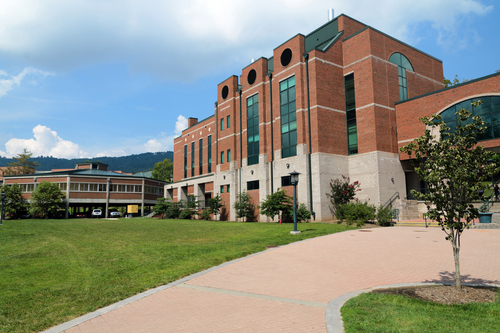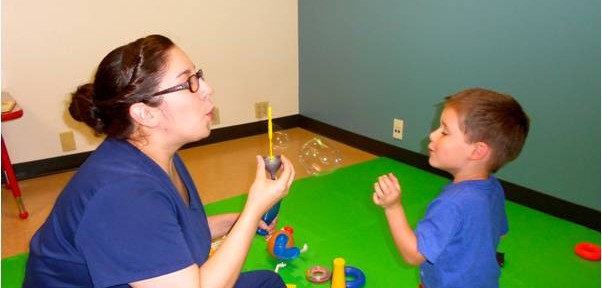
With her son Devin’s needs in mind, A.J. Paton-Wildes chose neutral colors for the walls and new flooring in the living room of their Oak Park Heights, Minn., home. As an interior designer, Paton-Wildes incorporates her personal experience with Devin, who has autism, to help create calming spaces for those on the spectrum. (Jeff Wheeler/Minneapolis Star Tribune/TNS)
MINNEAPOLIS — A.J. Paron-Wildes’ home, a walk-out rambler in suburban Oak Park Heights, Minn., is a study in calm — all clean, uncluttered spaces and earthy, neutral hues that echo the autumn leaves framing the view of the St. Croix River. On an autumn afternoon, daughter Eva, 6, is having an after-school snack, while son Devin, 19, sketches intently, seated at the studio desk in his orderly bedroom.
This peaceful environment is entirely by design. When you have a child child with autism, calm is a precious commodity — and Paron-Wildes has become an expert at creating it, starting in her own home.
That journey started 16 years ago when Devin was diagnosed with autism at age 3. “It was very traumatic,” Paron-Wildes recalled.
At that time, Devin didn’t speak but was prone to explosive tantrums when he was upset or confused. “He’d drop to the floor and start screaming.” She and her husband stopped bringing Devin to the grocery store or on other errands because they never knew what might trigger an eruption. “We’d have to drop everything and leave.”
At the time of Devin’s diagnosis, Paron-Wildes was a very young interior designer, only recently graduated from the University of Minnesota. “I thought, ‘There’s got to be some great research’” about designing spaces for children with autism, but she was wrong. “There was nothing,” she recalled. “Everything was done in the ’70s, when kids were institutionalized.”
Determined to keep Devin at home, Paron-Wildes committed herself to creating an environment where he could learn and thrive. So she started educating herself — by working backwards.
She read books about autism, and pored over studies about the neurological workings of the brain, becoming fascinated by the different ways people with autism perceive colors, patterns and lighting. She tried to determine what design elements would likely trigger difficult behavior — and then did the opposite, learning through trial and error.
“You can’t really get the information by asking, ‘Is this too bright for you?’ ‘Does this make you dizzy?’ You have to watch for cues,” she said.
Devin, too, was watching for cues. That’s a necessary strategy for children with autism, who usually develop language skills much later than their peers. Those who have difficulty communicating verbally often look to their environment for cues about what’s happening and how they should respond, Paron-Wildes said. They crave order and are easily distracted by its absence. They read meaning into seemingly random visual signals, and tend to be hypersensitive to harsh artificial light and to environmental toxins.
Paron-Wildes learned that the Crayola-bright, busy spaces most people consider kid-friendly — “like Ronald McDonald threw up” — are so stimulating that they can easily confuse and overwhelm a child with autism.
She remembers taking a young Devin to speech therapy — “in a room with a jungle gym and kids running around screaming.” The lesson was going nowhere, until she suggested moving it to a closet, the only quiet place available. There, Devin started to respond.
Information about autism and design may have been scarce when Paron-Wildes began searching for it, but that’s changing as autism rates have soared. The incidence may now be as high as 1 in 50 children, a 72 percent increase since 2007, according to a 2013 report from the U.S. Department of Health and Human Services and the U.S. Centers for Disease Control and Prevention.
That means Paron-Wildes’ expertise is increasingly in demand. “People think, ‘Oh, I have to redesign my whole house?’” she said. “No. Pay attention to the areas where the child needs to learn.” Those areas, as well as rooms where children rest and sleep, should be well-organized and orderly, with minimal distraction and muted, warm colors. “I’ve painted many little boys’ rooms pink — it tends to be a calming color,” she said.
She has worked with the University of Minnesota to develop research and design principles, co-chaired the Minnesota Autism Task Force, has written a trilogy of e-books on “Design for Autism” and spoke on “Design Empathy” for architects at a recent AIA Minnesota convention.
The bouncy, enthusiastic designer managed to work an autism joke — with a message — into her presentation. Pointing out a mustard-yellow circle at the corner of each page of her PowerPoint, she asked: “How many of you are wondering what that is there for? I did that to confuse you!” she added with a girlish laugh. “That’s what it’s like for kids (with autism).”
A designer for the AllSteel workplace furniture firm, Paron-Wildes also consults with schools, medical facilities and other organizations that serve children with autism and their families. (Most of her consulting work is done pro bono.) At this point, she could probably do autism-related design full-time, but she enjoys working on a wide range of projects. “If my whole life was autism, I would lose perspective.”
One recent consulting project involved working with designers from Perkins + Will on a new space for Fraser, a program Devin attended from age 3 to 6. The designers transformed a former Life Time Fitness office into a speech and occupational therapy site for children with autism and others.
Paron-Wildes pointed out design features on a recent visit. Treatment rooms and “meltdown areas,” where children often struggle with transitions from one activity to another, are quiet and neutral. “It’s easier to add color than to take it away,” she said. In other areas, brighter hues are used as way-finding cues, guiding children down hallways and to color-coded cubbies. Most flooring is kept simple. “If you make a pattern, the kids will follow it.”
There’s a lot more color and pattern in the reception area, however, where parents wait for their children and sometimes meet with therapists.
“One of the biggest complaints in centers is that parents feel like they’re in an institution,” Paron-Wildes said. She vividly remembers the stark waiting room she sat in when she first heard Devin’s diagnosis 16 years ago. “It felt very institutional. There was nothing to look at. It added to the aloneness and trauma.”
Parents feel calmer and more comfortable in a vibrant, upbeat environment. “It’s all psychological,” she said. “These parents want to feel like their child is going to a school — a fun school — not to treatment.”
Today, Devin is a verbal and affectionate teen who graduated from high school, went to prom and has developed into a gifted artist. He hopes to study art further; his work has won numerous awards and is proudly displayed throughout the family’s house.
That house, too, was chosen and designed with Devin’s needs in mind. Up until last year, Paron-Wildes and her family lived in a historic house in Stillwater, Minn. It was not calm, at least not after Devin’s sister joined the family. “We didn’t think we’d have a second kid,” Paron-Wildes said. “Then we had Ava. She’s a screamer. It was hard on Devin. We were having a lot of behavioral issues.”
So they found another house, one with plenty of separation between the kids’ rooms. Devin has a large bedroom with a lofted ceiling and a big window overlooking the river. “It’s really quiet up here; the 6-year-old doesn’t bother him,” his mother said. His room has lots of natural light and views of nature, which he loves studying through his telescope. There’s even an adjacent “Lego room” where he can retreat to build elaborate structures. Devin didn’t want to move at first — transitions are still difficult — and threatened to run away. But he soon adjusted. “He is so comfortable here — he loves his space,” Paron-Wildes said. “We have zero issues now.”
By KIM PALMER, STAR TRIBUNE/TNS December 10, 2014
Copyright © 2014 Disability Scoop, LLC. All Rights Reserved








